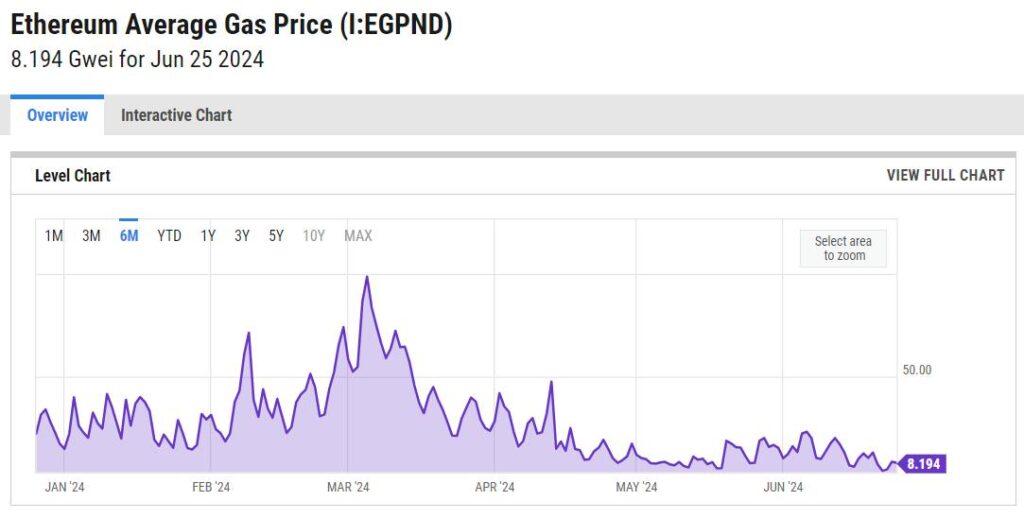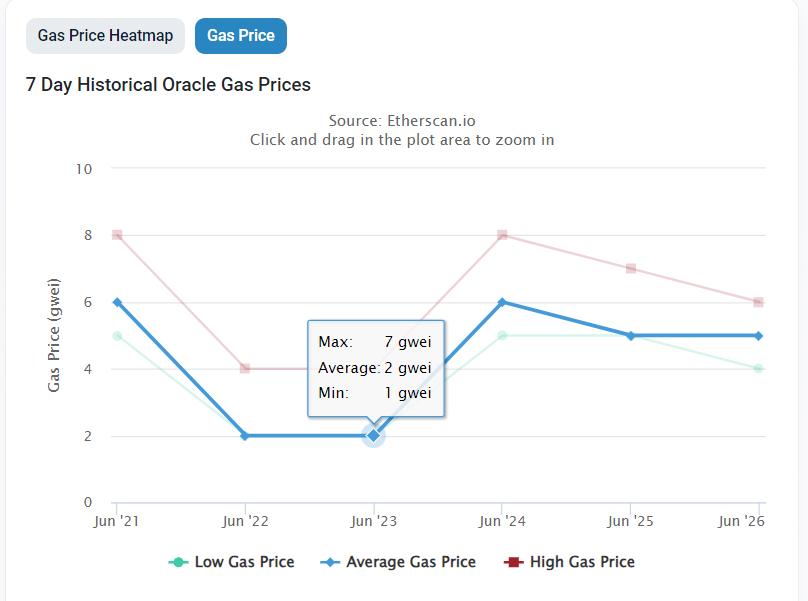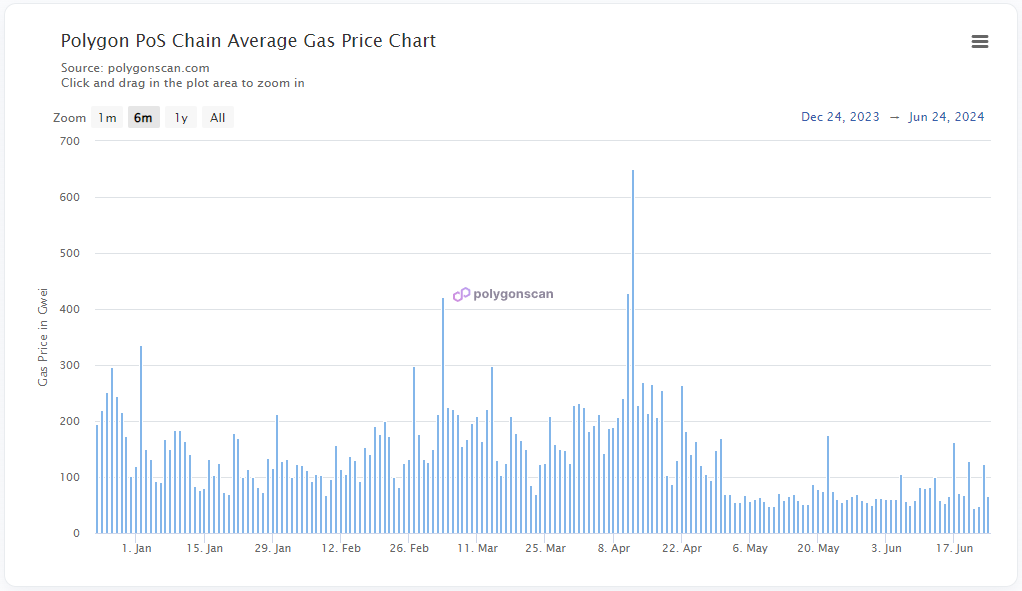The Dencun Upgrade introduced the concept of “blobs”, which helped process multiple transactions at the cost of one. The upgrade, a part of the Surge series of upgrades, helped decrease gas demand by large protocols; thereby reducing its demand and price. As a result, Layer-2 and Layer-3 protocols could now charge even less as they could post multiple Ethereum transactions at the cost of one.
In this article, we will explore the meaning, history, and workings of the Dencun Upgrade and evaluate its benefits.
Do you know how blockchain network congestion appeared on the scene?
Why Was the Upgrade Necessary?
Before the upgrade, the Ethereum blockchain was clogged. Transactions were being finalized with an extremely slow speed of 10-15 Transactions Per Second (TPS).
Since the network remained clogged, the transaction costs sometimes jumped over 300 Gwei as gas fees were always above 150 Gwei. Top users like Layer-2s, Layer-3s, Swap Protocols, DeFi protocols, and Dapps utilized a lot of gas, making them expensive for non-frequent users like retail users.
This situation was very troublesome for the greater adoption of Ethereum because most crypto transactions are usually below $100. Paying a network fee of $50 or more (which was the usual case) did not make any sense.
Other blockchains, such as Solana, Cardano, and XRP Ledger, were way ahead and processed thousands of transactions per second. As a result, Ethereum faced the risk of abandonment.
History
The Dencun Upgrade was conceived as a stop-gap measure to increase Ethereum’s network speed.
Originally, Ethereum was to be scaled with Sharding, where all the validators would be divided into groups, called shards, and each group would be able to act independently of each other, and all groups could add new blocks to the chain.
However, implementation was not easy at a time when Ethereum had just implemented a major transition from proof of work consensus to proof of stake consensus, and the upgrade was called “The Merge”.
Understand the difference between proof of work and proof of stake.

Hence, a proposal was sent by Dankrad Feist, cryptographer and Ethereum researcher. The proposal was further acted upon and soon took a final shape. Dankrad Feist and Protolambda (Diederik Loerakker) became the main contributors, with Vitalik Buterin, George Kadianakis, Matt Garnett, Ansgar Dietrichs and Mofi Taiwo acting as the authors of the proposal.
As a result of the efforts of the two main researchers, Dankrad Feist and Protolambda, the proposal was named “Proto-Dank Sharding”.
How Does it Work?
The working of the upgrade was meant to achieve two targets. First, it should increase the throughput and de-congest the Ethereum blockchain. Second, it should create a stepping stone for the final upgrade in this series, i.e., the Surge.
The upgrade introduced a new feature on the Ethereum block called a “blob”. A blob is an additional storage space inside an Ethereum block that was not accessible to the EVM, but its commit was accessible to it.
In simple words, this means the data (i.e., transactions) inside the “blob” was not to be verified, and only its commit, the summary of the data, will be verified by Ethereum validators.
Now, since the data was not to be verified, there had to be a method to make sure that the data was legitimate.
The upgrade drew inspiration from Layer-2s, which used Rollups to package Ethereum transactions and verify only their summaries. Due to Merkle Trees, if a single transaction is manipulated in the package, the entire summary will not fit in the blockchain and will be rejected. This feature ensures that transactions inside the rollup are as genuine as other transactions.
The Dencun Upgrade uses “blobs” to achieve the above functionality. Blobs are temporary on-chain storage that stores individual transactions that are packaged together. Once sufficient time has passed after the summary of the Blob is found valid, the individual transactions are deleted and only the summary is kept on-chain as a single transaction.
How Are Blobs Used in Ethereum?
It is noteworthy that Blobs are not meant for retail and individual transactions. Rather, they are meant for protocols that use a lot of gas, also known as “Gas Guzzlers”. These protocols that relied on L2s earlier now have direct access to Ethereum, making them more secure and trustworthy.
A few examples of gas guzzlers are Polygon, Arbitrum, Uniswap, and Tether.
Below is a simplified explanation of how the Blob transactions work.
- Once a transaction is posted, it is sent to a blob.
- As soon as the blob is filled, its summary is generated by hashing the individual transactions and generating a Merkle root.
- The Merkle root is then validated on Ethereum. In the verification process, the initial state of the blockchain before the blob and the final state of the blockchain must differ from the change introduced by the blob summary.
- Once the summary is finalized, it is added to the blockchain as a simple transaction.
- After a few days, the data inside the blob is deleted, and the blob is ready to be filled with more transactions.
Benefits of Implementing The Dencun Upgrade
The greatest benefit of the upgrade went to Ethereum, however, L2 and L3 coins were not left behind. As a result of decreased fees on these protocols, the project coins rallied after the upgrade.
If you want to know which L2 or L3 tokens to buy, you first should know how to analyze them.
Low Fees
As a direct benefit of the Dencun Upgrade, several layer-2 and layer-3 projects began using blobs to summarize bulk transactions. These helped them save costs vis-a-vis posting them directly on Ethereum. This helped decrease the demand for gas on Ethereum, due to which gas prices gradually cooled down.
The chart below shows the trend in gas prices after the Dencun Upgrade went live on March 13, 2024.

The gas demand reduced to the extent that gas prices crashed from an average fee of 98 Gwei on March 5th to just 8 Gwei on June 22nd. Further, the minimum gas fee even fell down to just 1 Gwei.

Better Security
Earlier, the usage of L2 chains for off-chain data storage posed some risks even after the verification of its Merkle root. With an ever-growing L2 and L2 market, the risk of fraud also rose.
With the usage of blobs, the data is now stored on the Ethereum blockchain, lending it more credibility with the highest security.
Little To No Network Congestion
The upgrade was crucial in addressing the network congestion. With blobs, bulk gas buyers switched to a cheaper way of processing transactions on Ethereum. This freed up gas, which could now be used for less frequent users at an affordable price. Low gas prices also meant higher usage of Ethereum.
The usage of blobs by layer-2 solutions also resulted in a less expensive way for them to post transactions on the Ethereum blockchain. This helped them further decrease their fee to a level where it is virtually free.

Conclusion
The Dencun Upgrade helped reduce the demand for gas by introducing the concept of blobs. This feature allows multiple transactions to be made at the cost of one. The use of blobs by Layer-2 and Layer-3 protocols reduced their gas consumption and made them more cheaply available for less frequent users, such as individual users. The upgrade was so successful that within a period of four months, Ethereum’s gas price fell from an average of 150 Gwei to just 1 Gwei.




















